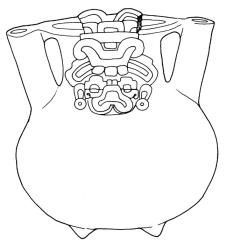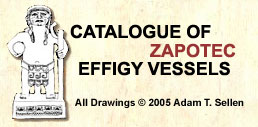| Key: MNA t/103, antecámara | | Actual Location: National Anthropology Museum, Mexico City, Mexico. | | Provenance: Antechamber of tomb 103, Monte Albán, Oaxaca. | | Measurements: 20 cm. | | Chronology: Peche 500 - 600 AD | | Click to view Chronology | | Reference: Caso and Bernal 1952: 40, fig. 17 (drawing). | | Comments: This piece, a pot with two pouring handles, decorated in front with a Cocijo head, was found in the antechamber of tomb 103. Next to this piece, an effigy vessel representing a female human figure (MNA 6-4852), a cylindrical polished black glass and a few fragments of earthenware with fresco polychromed decorations were found. The tomb was excavated by Caso in the sixth period (1937). For a very similar ceramic set, see EMB 11157, EMB 11158, EMB 11159 and EMB 11156. | |
| | 
Click to view high resolution in a new window
select this image for review |
